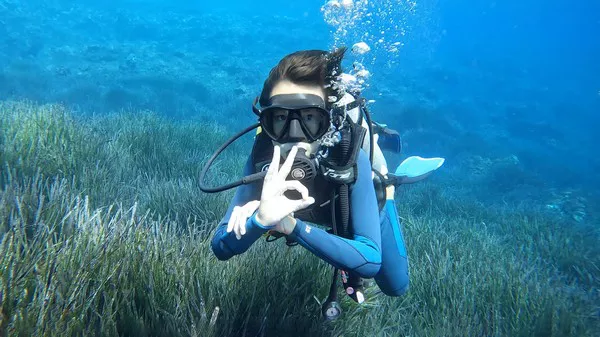Open water diving represents the gateway to the underwater world, offering enthusiasts a thrilling and immersive experience beneath the waves. This form of diving allows individuals to explore the depths of oceans, lakes, or other natural bodies of water, free from the constraints of enclosed spaces. It’s an adventure that combines exploration with a profound connection to nature, requiring specific skills, training, and equipment to ensure safety and enjoyment.
Understanding Open Water Diving
At its core, open water diving refers to diving in unrestricted bodies of water, such as oceans, seas, or large lakes, where there is direct access to the surface. Unlike confined spaces like swimming pools or indoor dive tanks, open water diving presents divers with the opportunity to encounter natural marine environments, complete with marine life, coral reefs, and underwater landscapes. This type of diving often involves descent to considerable depths, making it essential for divers to understand the principles of buoyancy, pressure, and safety protocols.
Training and Certification
Before embarking on open water dives, individuals must undergo proper training and attain certification from recognized diving organizations such as PADI (Professional Association of Diving Instructors) or NAUI (National Association of Underwater Instructors). These courses cover essential topics including dive theory, equipment usage, safety procedures, and environmental awareness. Certification is typically achieved through a combination of classroom sessions, confined water training, and open water dives under the supervision of experienced instructors.
Essential Equipment for Open Water Diving
Diving in open water requires specialized equipment designed to ensure comfort, safety, and functionality underwater. Key items include:
- Diving Mask: Provides a clear view underwater while creating an air pocket for the eyes.
- Wetsuit or Drysuit: Maintains body temperature and protects against exposure to cold water.
- Buoyancy Control Device (BCD): Helps control buoyancy by adjusting air volume.
- Regulator: Delivers air from the scuba tank to the diver’s mouth.
- Dive Computer: Monitors depth, time, and decompression limits during a dive.
- Fins: Aid in propulsion and maneuverability underwater.
- Weights: Compensate for buoyancy and help achieve neutral buoyancy.
Each piece of equipment plays a crucial role in ensuring the diver’s safety and comfort while exploring the underwater world.
Safety Precautions
Safety is paramount in open water diving due to the unique challenges posed by the underwater environment. Divers must adhere to strict safety protocols to minimize risks and ensure a positive diving experience:
- Dive Planning: Always plan dives in advance, considering factors such as depth, currents, and weather conditions.
- Buddy System: Dive with a buddy to provide mutual support and assistance in case of emergencies.
- Equalization: Learn proper techniques for equalizing pressure in the ears and sinuses to prevent discomfort or injury.
- Emergency Procedures: Familiarize yourself with emergency protocols, including ascent procedures, buoyant ascent techniques, and use of safety equipment.
By prioritizing safety and adhering to established guidelines, divers can mitigate potential risks and fully enjoy the wonders of open water exploration.
Environmental Awareness
Open water divers have a unique opportunity to witness marine life and ecosystems firsthand. It is essential to practice responsible diving to minimize impact on delicate underwater environments:
- Respect Marine Life: Observe marine life from a distance, avoiding contact or disturbance.
- Avoid Pollutants: Refrain from dropping or leaving behind any waste or debris.
- Support Conservation Efforts: Participate in conservation initiatives to protect marine habitats and species.
By promoting environmental awareness and responsible behavior, divers can contribute to the preservation of our oceans for future generations.
Popular Open Water Diving Destinations
The allure of open water diving attracts enthusiasts to diverse locations around the world, each offering unique underwater landscapes and marine biodiversity:
- Great Barrier Reef, Australia: Explore the world’s largest coral reef system, home to a dazzling array of marine life.
- Red Sea, Egypt: Discover vibrant coral reefs and ancient shipwrecks in the crystal-clear waters of the Red Sea.
- Maui, Hawaii: Dive amidst sea turtles, colorful fish, and volcanic formations in the warm waters of Maui.
- Bonaire, Caribbean: Enjoy excellent visibility and easy shore diving in this diver’s paradise.
These destinations represent just a few of the many incredible locations where open water divers can immerse themselves in nature’s beauty.
Conclusion
Open water diving offers a profound and transformative experience, allowing individuals to explore the mysteries of the underwater world firsthand. From vibrant coral reefs to majestic marine life, this form of diving presents endless opportunities for adventure and discovery. However, it also requires dedication to safety, environmental stewardship, and ongoing skill development.
Whether you’re a seasoned diver or just beginning your underwater journey, open water diving promises an unforgettable exploration of nature’s most captivating realm—the ocean depths. By embracing the principles of safety, education, and environmental awareness, divers can forge a deeper connection with our planet’s precious aquatic ecosystems, fostering a sense of wonder and responsibility for the oceans that sustain us.

